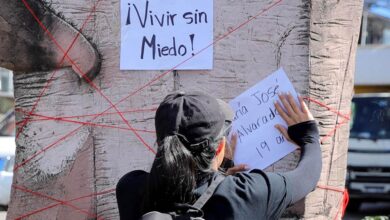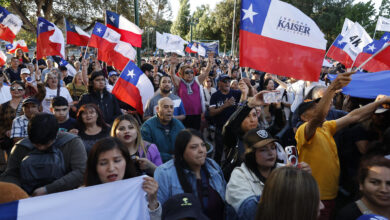The difference between the left of Gabriel Boric and that of Pedro Castillo
In the last elections in Peru and Chile, the left has returned to power, although with many nuances between that of Gabriel Boric and that of Pedro Castillo
In the last elections in Peru and Chile, the left has returned to power, although with many nuances between that of Gabriel Boric and that of Pedro Castillo

Photos: TW-PedroCastilloTe, TW-gabrielboric
LatinAmerican Post | Nicolás Donoso
In 2021, elections of various kinds were held throughout the continent. In Peru, during the month of June, Pedro Castillo defeated the Popular Force candidate Keiko Fujimori in the second round and became the new president of the Inca country.
While in Chile, the young 35-year-old deputy, Gabriel Boric, defeated far-right José Antonio Kast by a wide margin last December (also in the second round) and put an end to the years of a government that the center-left and the center-right since the return to democracy.
Consequently, the political map of Latin America has taken a new turn, but one of the many questions that remain to be resolved is whether, in this case, Gabriel Boric and Pedro Castillo really represent a more radical left or whether their proposals are more moderate, far from the great extremes that generate fear in the population. How are they similar? How are they different?
Similar Initial Political Supports, Different Cabinets
Initially, when Professor Pedro Castillo ran for president, he represented Peru Libre, a left-wing political party that many views as the most extreme left, due to its Marxist-Leninist ideology. However, the current president realized that he cannot govern solely with his political conglomerate, which led him to try to expand his cabinet and change it on more than one occasion; dividing the party to which he belongs.
Salvador Allende’s Granddaughter and Other Surprises From Boric’s New Cabinet in Chile
In the case of Gabriel Boric, although there are still days to go before the new president takes office (he will do so on March 11), at the beginning of his campaign he formed an alliance called I Approve Dignity, which brought together to the Broad Front and the Communist Party, leaving aside the center-left that governed the country for practically 20 years.
However, Boric had to moderate his speech in the middle of the presidential campaign, and when he was elected as the new president, this became even more evident with the recent appointment of his cabinet. And it is that his team of ministers and ministers is made up of just a handful of members of the Communist Party, and the former Concertación is positioned as a key force with the presence of politicians from the Socialist Party, the Radical Party, the Liberal Party and the Party for the Democracy; In addition, it is a mostly female cabinet and very young in its composition, setting the standard in the continent.
The economy, a factor that differentiates them
In economic matters, both wanted to make profound transformations in the neoliberal systems that prevail in both nations. However, Pedro Castillo believes to a greater extent in state intervention, where the nationalization of large companies is sought and the monopolies that he himself has mentioned exist in Peru are ended. This has been made clear in several interviews before and after taking office.
?? | Pedro Castillo, el candidato más votado en las elecciones presidenciales peruanas, pide expropiar todas las empresas monopólicas, pero no sabe definir qué es un monopolio.pic.twitter.com/6gqq0BNFXW
— La Derecha Diario (@laderechadiario) April 14, 2021
Boric, for his part, clings to overcoming the economic crisis that the country is going through as a result of the pandemic by the coronavirus, since that has brought the loss of thousands of jobs, the appearance of state aid with bonds, and the controversial withdrawals of pension funds to weather the difficult moment. It also plans to improve pensions and job creation, emphasizing female labor and the forgiveness of state-backed credit, a mechanism with which many students have been able to pursue their studies in higher education, but when they graduate they must pay the debt for many years.
Carrying out all these measures seems utopian considering the complicated panorama that the country, the continent, and the world are going through, and for this reason, Gabriel Boric appointed the now-former president of the Central Bank of Chile, Mario Marcel, as the new Minister of Finance, seeking to calm the detractors and progressively carry out the economic program of his government.
Human rights are seen from different perspectives
Despite being a president who comes from a leftist political party, Pedro Castillo has proven to be quite conservative in social matters. He is against -sex marriage, abortion on three grounds, euthanasia, immigration on more than one occasion, and the focus on gender equality in primary and secondary schools.
With these positions, he substantially distances himself from the member of Social Convergence. Boric is part of a much more progressive left in terms of Human Rights. The future Chilean president is totally in favor of same-sex marriage, home parental adoption, free, safe, and free abortion, and a “regular, orderly, and safe” immigration policy, according to his own government program.
On points where they do agree is that their countries need a new Constitution and while in the case of Chile the new Magna Carta is already being drafted to later be voted on in an exit ratification plebiscite to see if it is approved or rejected its wording, in the case of Peru they have not been able to consolidate the idea towards a new Constitution, mainly because in Congress the president does not have majorities and is unable to reach agreements.
Although Castillo and Boric seem to represent the same sector, they are opposites in many of their ideas, in the support they receive, and in the agreements, they aspire to reach.





